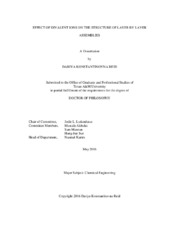| dc.contributor.advisor | Lutkenhaus, Jodie | |
| dc.creator | Reid, Dariya Konstantinovna | |
| dc.date.accessioned | 2016-07-08T15:12:59Z | |
| dc.date.available | 2018-05-01T05:48:48Z | |
| dc.date.created | 2016-05 | |
| dc.date.issued | 2016-05-02 | |
| dc.date.submitted | May 2016 | |
| dc.identifier.uri | https://hdl.handle.net/1969.1/156972 | |
| dc.description.abstract | The effects of ion concentration and type on the structural and fundamental property changes in poly(diallyldimethylammonium chloride) (PDAC) / poly(styrene sulfonate) (PSS) layer-by-layer (LbL) assemblies are investigated. These properties are monitored using quartz crystal microbalance with dissipation (QCM-D) and modulated differential scanning calorimetry (MDSC). PDAC-terminated multilayers reveal concentration dependent thickness changes upon exchange of contact solutions between NaCl and divalent cation salts (CaCl2 and MgCl2). At low concentrations, thickness changes increase with decreasing concentration, while at high ionic strength the opposite trend is observed. Alternatively, the LbL film exhibits similar behavior but no concentration dependence, when in the presence of divalent anion salt (Na2SO4). The observed expansion of the films when exposed to divalent ion salts is analyzed in terms of the hydration efficiency of the ions and osmotic pressure. Mechanical properties of the film mirror the structural changes with the film becoming more rigid and bearing a higher shear modulus when in the presence of NaCl. These changes are attributed to the plasticizing effect of water molecules. Thermal changes in hydrated PDAC/PSS assemblies are also monitored with respect to the type of ions present in the hydrating solution and the ionic strength of the solution. Unlike structural behavior, the thermal transition (Ttr) observed in hydrated films shifts to higher temperatures with increasing concentration of Na2SO4. However, when hydrated with CaCl2 or MgCl2 solutions the Ttr remains constant within standard deviation. The effect of chaotropic/kosmotropic character of the ions is considered when drawing conclusions regarding the Ttr behavior. | en |
| dc.format.mimetype | application/pdf | |
| dc.language.iso | en | |
| dc.subject | swelling | en |
| dc.subject | PDAC | en |
| dc.subject | PSS | en |
| dc.subject | layer-by-layer | en |
| dc.subject | LbL | en |
| dc.subject | polyelectrolyte multilayers | en |
| dc.subject | multivalent ions | en |
| dc.subject | QCM-D | en |
| dc.subject | MDSC | en |
| dc.title | Effect of Divalent Ions on the Structure of Layer by Layer Assemblies | en |
| dc.type | Thesis | en |
| thesis.degree.department | Chemical Engineering | en |
| thesis.degree.discipline | Chemical Engineering | en |
| thesis.degree.grantor | Texas A & M University | en |
| thesis.degree.name | Doctor of Philosophy | en |
| thesis.degree.level | Doctoral | en |
| dc.contributor.committeeMember | Akbulut, Mustafa | |
| dc.contributor.committeeMember | Mannan, Sam | |
| dc.contributor.committeeMember | Sue, Hung-Jue | |
| dc.type.material | text | en |
| dc.date.updated | 2016-07-08T15:12:59Z | |
| local.embargo.terms | 2018-05-01 | |
| local.etdauthor.orcid | 0000-0002-9244-8499 | |


